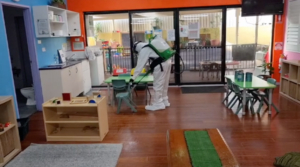In the intricate dance of parenthood, ensuring the safety and well-being of our children is paramount. Amidst the daily juggle of responsibilities, one aspect that often gets overlooked is the cleanliness of childcare environments. Yet, the importance of proper childcare cleaning practices cannot be overstated. From daycare centers to preschools, these spaces are breeding grounds for germs and bacteria, posing significant health risks to our little ones. In an era where contagious diseases can spread like wildfire, maintaining a hygienic environment is crucial for safeguarding children’s health. Moreover, beyond physical health concerns, cleanliness also impacts cognitive development and overall well-being. A clean, organized space fosters a conducive learning environment, stimulating young minds and promoting positive behaviors.
In this article, we delve into the significance of prioritizing cleanliness in childcare settings, exploring the benefits it offers in terms of health, safety, and child development. Let’s unravel the layers of why proper childcare cleaning practices are not just desirable but imperative in nurturing our future generation.
Putting Safety First: Best Practices for Cleaning Childcare Facilities

Ensuring the safety and well-being of children is paramount in childcare facilities. While providing a nurturing environment for growth and development, these spaces also harbor potential hazards that can compromise the health of children and staff alike. Proper cleaning practices are not just about aesthetics; they are fundamental to maintaining a safe and healthy environment. In this guide, we’ll explore eight essential best practices for cleaning childcare facilities, emphasizing safety at every step.
Conduct Regular Risk Assessments
Begin by identifying potential hazards within the childcare facility. Conduct regular risk assessments to pinpoint areas that require special attention during cleaning. This may include high-traffic zones, play areas, and facilities prone to moisture buildup, such as bathrooms and kitchens. By proactively identifying risks, you can tailor your cleaning efforts to address specific challenges effectively.
Implement Comprehensive Cleaning Protocols
Develop comprehensive cleaning protocols that outline specific tasks, schedules, and products to be used. Assign clear responsibilities to staff members and provide thorough training on proper cleaning techniques. Establishing standardized protocols ensures consistency and efficiency in cleaning practices, minimizing the risk of oversight or neglect.
Prioritize Hygiene Hotspots
Certain areas within childcare facilities are hotspots for germs and contaminants. Pay special attention to frequently touched surfaces, such as doorknobs, light switches, and toys. Implement a rigorous disinfection routine for these areas, using EPA-approved disinfectants to effectively kill bacteria and viruses. By targeting hygiene hotspots, you can significantly reduce the risk of illness transmission among children and staff.
Select Safe and Effective Cleaning Products
Choose cleaning products that are safe for use in childcare environments and effective in eliminating pathogens. Look for non-toxic, eco-friendly options that minimize exposure to harmful chemicals. Ensure that all cleaning products are properly diluted and used according to manufacturer instructions to maximize efficacy and safety.
Promote Proper Ventilation
Good indoor air quality is essential for maintaining a healthy childcare environment. Promote proper ventilation by opening windows and doors whenever possible to allow fresh air circulation. Use exhaust fans in bathrooms and kitchens to reduce moisture buildup, which can contribute to mold growth and indoor air pollution. Adequate ventilation not only improves air quality but also helps prevent the spread of airborne pathogens.
Empowering Staff: Training for Effective Childcare Cleaning Practices
In childcare facilities, the well-being of children hinges on cleanliness. Empowering staff with proper training in effective cleaning practices is essential for maintaining a safe and healthy environment. From understanding the importance of hygiene to mastering specific techniques, comprehensive training equips staff to uphold rigorous cleaning standards. Let’s delve into key points for empowering staff through training in childcare cleaning practices.
- Mastering Cleaning Techniques: Provide hands-on training in effective cleaning techniques, including proper disinfection methods, surface cleaning, and equipment operation. Ensure staff understand the importance of thoroughness and attention to detail in their cleaning duties.
- Safety First: Prioritize safety in cleaning practices. Train staff on the safe handling and storage of cleaning products, as well as the use of personal protective equipment (PPE) when necessary. Emphasize the importance of avoiding hazards and preventing accidents.
- Tailoring Cleaning to Childcare Needs: Customize training to address the unique cleaning challenges of childcare facilities, such as sanitizing toys, maintaining play areas, and ensuring food preparation areas meet hygiene standards. Equip staff with the knowledge and skills needed to address these specific needs effectively.
- Consistency is Key: Stress the importance of consistency in cleaning routines. Encourage staff to adhere to established protocols and schedules to maintain a clean and hygienic environment consistently. Provide tools, such as checklists or cleaning logs, to help staff track their cleaning tasks.
Empowering staff through comprehensive training in childcare cleaning practices is vital for maintaining a safe and healthy environment for children.
Eco-Friendly Cleaning: Sustainable Practices for Childcare Centers
As stewards of the environment, it’s essential for childcare centers to prioritize eco-friendly cleaning practices. Traditional cleaning methods often rely on harsh chemicals that can be harmful to both the planet and the health of children and staff. By embracing sustainable cleaning practices, childcare centers can reduce their environmental footprint while creating a healthier and safer environment for everyone. In this guide, we’ll explore eight sustainable practices for eco-friendly cleaning in childcare centers, ensuring a clean and green future for generations to come.
Choose Green Cleaning Products
Opt for cleaning products that are certified as environmentally friendly and free from harmful chemicals. Look for eco-labels such as Green Seal or EcoLogo, which indicate that the product meets strict environmental and performance standards. Use plant-based, biodegradable cleaners that are safe for use around children and minimize pollution in waterways.
Reduce, Reuse, Recycle
Implement a waste reduction strategy that emphasizes the principles of reduce, reuse, and recycle. Minimize single-use plastic waste by purchasing cleaning products in bulk or opting for refillable containers. Encourage staff to use reusable cleaning cloths and mop heads instead of disposable alternatives. Set up recycling stations throughout the childcare center to promote proper waste segregation and recycling.
Conserve Water and Energy
Practice water and energy conservation in cleaning operations to minimize environmental impact. Use low-flow faucets and water-efficient cleaning equipment to reduce water consumption. Turn off lights and appliances when not in use and invest in energy-efficient cleaning appliances to lower electricity usage. By conserving water and energy, childcare centers can decrease their carbon footprint and contribute to a greener future.
Implement Microfiber Technology
Utilize microfiber cleaning cloths and mop heads, which are highly effective at trapping dirt and dust without the need for chemical cleaners. Microfiber technology requires less water and cleaning solution compared to traditional methods, making it an eco-friendly choice for childcare cleaning. Additionally, microfiber materials are durable and can be laundered and reused multiple times, reducing waste and saving resources.
Harness the Power of Steam Cleaning
Steam cleaning is an eco-friendly alternative to traditional chemical-based cleaning methods. Using high-temperature steam, this technology effectively disinfects and sanitizes surfaces without the need for harsh chemicals. Steam cleaning also eliminates the use of disposable cleaning pads and reduces water consumption, making it a sustainable choice for childcare centers concerned about environmental impact.
Conclusion
At Clean Group in Sydney, we recognize the paramount importance of implementing proper childcare cleaning practices. Our commitment extends beyond mere cleanliness; it encompasses safeguarding the health and well-being of the children under our care. Through meticulous attention to detail and adherence to rigorous sanitation protocols, we prioritize creating a safe and hygienic environment conducive to the development and growth of every child. With our dedicated approach, we strive to set a standard of excellence in childcare cleaning, ensuring peace of mind for parents and caregivers alike.

